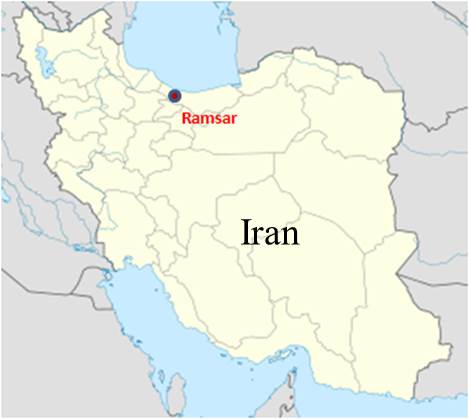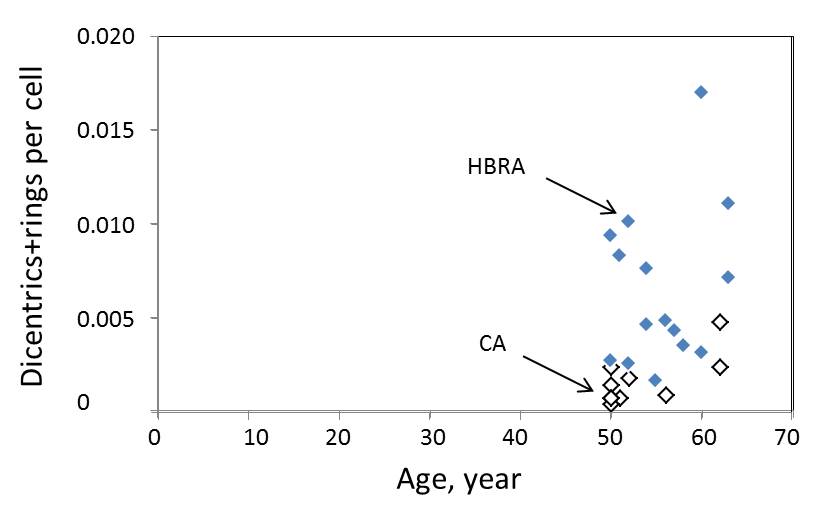| Residents of High Natural Background Radiation Area |
Background radiation in the environment comprises
of variety of sources including both natural and artificial radiation.
Natural background radiation (NBR) is defined as radiation of the non-artificial
sources of apparent origin and sometimes simply referred to as background
radiation (BR) for the environmental interest. Its origin is inhalation
of air (mainly 222Ra), ingestion of food
and water (40K, 14C, etc.), terrestrial radiation from
ground (depending on soil materials), and cosmic radiation (solar and galactic
origin). The levels of natural background radiation vary with location, time
and altitude. The global average effective dose to humans has been estimated to
be 2.40 mSv/year (UNSCEAR Report 2000). This level in Japan is 1.50 mSv/year (http://search.kankyo-housyasen.go.jp).
However, several regions in the world are
known as high background radiation area (here we call HBRA), where the
natural background radiation is far excess of the world average one. They
include Guarapari (Brazil), Kerala (India), Ramsar (Iran) and Yangjiang
(China). Since the exposure levels in these areas are several times (some
tenths of times in particular area) higher than the recommended limit for
exposure to the public from artificial sources (ICRP 2007 Recommendations;
1 mSv that may have a 5.5% chance of developing cancer), the health consequences
of the residents has been continued concern in radioprotection and radiobiological
sciences.
Scenario:
Ramsar is a city looking to the Caspian Sea
in northern Iran and known as the highest recorded natural background radiation
levels in the world. These are due to the local geology and hydrogeology
and, in some places, deliver high radiation doses (Ghiassi-nejad et al.
Health Phys., 82:87-93, 2002). The hot springs contain high levels of radium
(226Ra) and its decay product radon (222Rn).
The flow of hot spring water deposits radionuclides in soil resulting in high
radiation levels in Ramsar. The residents also use the hot spring sediment (limestone)
as building materials. These are the sources of high background radiation in
outside and inside the house (Sohrabi et al. 1996 cited from Zakeri et al.
Radiat. Env. Biophys., 50:571-578, 2011). For instance, a recorded effective
dose is 131 mSv/year due to ambient radiation field and 72 mSv/year for
internal committed dose from radon.
|
 |
| 2.1. Study populations and dosimetry |
Study populations
Cytogenetic investigation was performed in
age-matched elderly women; 15 in the high natural background radiation
area (HBRA) and 10 in the control area (CA). The residents of Telesh mahalle
were selected because it is reportedly to have the highest levels of natural
(terrestrial) radiation among other HBRAs of Ramsar. The potential annual
effective dose to the public in HBRA from external radiation (indoor and
outdoor) ranges from 0.7 to 131 mSv with a mean of 6 mSv, and those in
low level natural background radiation area ranges from 0.6 to 1.5 mSv
with a mean of 0.7 mSv. The internal dose due to 222Rn ranges from about
2.5 to 72 mSv Sourabi and Babapouran 2005, cited from Zakeri et al., Radiat.
Environ. Biophys., 50:571-578, 2011).
Dosimetry
The exposed dose was estimated from 1 day
reading of an electronic pocket dosimeter (EPDTM) carried by the subjects.
They also carried an optically stimulated luminescence dosimeter (luxel
badge thermoluminescence dosimeter, ODLD) for 1 month. Their individual
external doses were estimated from ambient radiation dose rates determined
with a NaI (Tl) survey meter and occupancy factors of the time and space
of concern.
|
2.2. Chromosome aberration analysis (Dicentrics+Rings)
|
|
All the subjects are non-smokers. Elderly
women have been chosen because aged individuals spend more time at home.
The blood samples were collected and processed within 2 h after collection.
The lymphocytes were separated and cultured for chromosome preparation.
|
|
References
|
|
Zakeri, F., Rajabpour, M. R., Haeri, S. A.,
Kanda, R., Hayata, I., Nakamura, S., Sugahara, T. and Ahmadpour, M. J.
(2011): Chromosome aberrations in peripheral blood lymphocytes of individuals
living in high background radiation areas of Ramsar, Ira. Radiat. Environ.
Biophys., 50:571-578.
|
| Subject |
Age |
WLD* |
Cells |
Chromosome aberrations |
|
Subject |
Age |
WLD* |
Cells |
Chromosome aberrations |
| code |
(y) |
EPD(mSv) |
OSLD(mSv) |
scored |
Dic+cR |
aR |
Ace |
Min |
|
code |
(y) |
EPD(mSv) |
OSLD(mSv) |
scored |
Dic+cR |
aR |
Ace |
Min |
| T1 |
51 |
112.20 |
222.87 |
4,690 |
10 |
1 |
28 |
4 |
|
K1 |
62 |
39.06 |
153.76 |
4,020 |
4 |
1 |
14 |
6 |
| T2 |
54 |
142.56 |
223.02 |
4,925 |
7 |
1 |
15 |
4 |
|
K2 |
52 |
30.68 |
110.76 |
2,879 |
1 |
0 |
4 |
0 |
| T3 |
60 |
95.40 |
218.40 |
3,180 |
14 |
3 |
37 |
5 |
|
K3 |
50 |
30.00 |
77.00 |
1,475 |
1 |
0 |
1 |
1 |
| T4 |
52 |
288.60 |
508.56 |
5,007 |
7 |
3 |
3 |
3 |
|
K4 |
51 |
29.58 |
108.63 |
3,000 |
2 |
0 |
0 |
1 |
| T5 |
63 |
78.75 |
159.50 |
2,935 |
7 |
1 |
13 |
8 |
|
K5 |
50 |
30.00 |
136.00 |
3,000 |
1 |
0 |
1 |
3 |
| T6 |
50 |
51.50 |
245.70 |
2,892 |
3 |
0 |
5 |
13 |
|
K6 |
50 |
32.50 |
77.00 |
3,000 |
1 |
0 |
0 |
3 |
| T7 |
54 |
142.56 |
248.40 |
1,830 |
4 |
0 |
10 |
5 |
|
K7 |
50 |
31.00 |
40.93 |
3,000 |
1 |
0 |
6 |
5 |
| T8 |
52 |
212.68 |
318.76 |
1,970 |
5 |
0 |
15 |
7 |
|
K8 |
62 |
35.34 |
102.92 |
3,000 |
2 |
1 |
4 |
3 |
| T9 |
60 |
147.60 |
255.00 |
2,832 |
4 |
0 |
5 |
2 |
|
K9 |
50 |
38.50 |
112.50 |
3,000 |
0 |
0 |
2 |
2 |
| T10 |
58 |
110.20 |
246.50 |
2,248 |
4 |
0 |
4 |
2 |
|
K10 |
56 |
36.96 |
119.50 |
2,521 |
1 |
0 |
1 |
0 |
| T11 |
50 |
217.50 |
1070.00 |
2,020 |
4 |
0 |
15 |
6 |
|
*) WLD: whole life accumulated dose. |
| T12 |
57 |
373.35 |
343.14 |
3,684 |
5 |
1 |
10 |
11 |
|
|
|
|
|
|
|
|
|
|
| T13 |
55 |
35.20 |
110.55 |
2,967 |
4 |
0 |
1 |
8 |
|
|
|
|
|
|
|
|
|
|
| T14 |
56 |
155.68 |
304.20 |
4,500 |
6 |
1 |
15 |
5 |
|
|
|
|
|
|
|
|
|
|
| T15 |
63 |
- |
- |
3,239 |
14 |
2 |
20 |
4 |
|
|
|
|
|
|
|
|
|
|
 |
Commentary
See also suggested age dependency of aberration
frequency and comparison with that in Yangjiang, China. |

